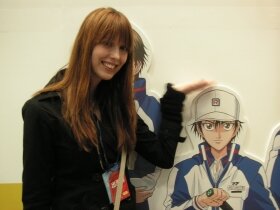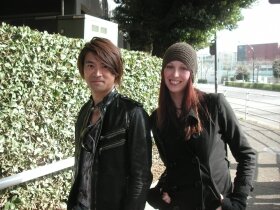 Filed under: Manga Otaku Fujoshi International
Filed under: Manga Otaku Fujoshi InternationalOtaku2 Interview: Jamie Lano
08.05.2009 by Patrick W. Galbraith
Jamie Lano, 28, moved from Washington to Tokyo five years ago. An artist and anime otaku, it seemed the right thing to do in lieu of oher plans. She is now an assistant on the popular "Prince of Tennis" manga, writes a column for "Asahi Weekly" and hosts TV show Asahi Pop'n Press." We sat down with her hoping to find the key to her success.
PG: What brought you to Japan?
JL: When the end of college was drawing near, I didn't have any idea what I wanted to do with my life. So, I just thought I’d spend a year living in the country that created the anime and manga that I loved.
PG: What drew you to manga?
JL: I guess that I've always been interested in comics and animation as an art form. But what really struck me about manga in specific was the amount of creative control that one person had over a story. Unlike animation or even American comics, the majority of the control over the plot remains with the manga artist or author, and not with a team. In American comics, it's common to see a series change authors and artists frequently-- sometimes every single issue. But in manga, while it takes a team of artists to create it, everything is based around one artist's vision. So, without that one artist, the manga wouldn't be possible anymore. That level of control really makes for some interesting stories, and I suppose that is what really drew me to it in terms of a career choice.
PG: Tell us about your career in manga.
JL: I am currently working for Konomi Takeshi, who is the artist and author of the huge hit "Prince of Tennis." This came about last year, when friends told me that he was recruiting for artists on the "JUMP Square" website for a new project. I had admired him for a long time, and I decided to give it a shot. I was 'hired' on a trial basis. Along with one, and eventually two other new assistants (and two returning), we worked on small promotional items, and spent most of our studio time practicing drawing, inking and screentone techniques. We also spent time going out to photograph locations that would be used in the upcoming sequel. I am aiming for my own debut sometime in the future! I have learned so much working in this studio over the last half a year, and with Konomi-sensei's support, I feel as if I will be able to do it. I am working on my own manga, which I will submit to the publishers. If it doesn't take, then I will try again, and again and again until I'm able to achieve the first step of this dream!
PG: What were the challenges?
JL: At first, the challenge for me was fitting into this new world. Basically, having spent most of my time in the English-speaking bubble that exists in Tokyo, I had to basically re-learn how to communicate and relate to people. All of my time spent with Japanese friends over the years had never prepared me for what it would like being away from my home for a week at a time with no access to computer or people that I usually talked to, completely enveloped in a language that I only half-understood. But with everyone's help and patience, I've been able to find my feet. All in all, although the marathon 10-day sessions where we draw for 15 hours a day sometimes gets to me, I've found that the benefits outweigh the hardships.
PG: Any words of advice for would-be mangaka overseas?
JL: Don't give up!! No matter what happens, keep your dream in hand and take any opportunities that are presented to you. Walk through any open doors, and don't let a chance slip by if you can help it!!
PG: What else are you doing?
JL: Coming up is the one-year anniversary of my column over at "Asahi Weekly." I'm also working on a new TV show with JCTV – "Asahi Pop'n Press."
PG: What's your favorite spot in Japan?
JL: This might sound really strange, but my favorite spot is this little shrine to kappa [water demons] over on the east side of Tokyo. I've never been able to catch it when its doors are open, but I've always longed to. Aside from that, I love to go hiking out on Mt. Takao. Sometimes I really miss nature.
PG: What's the most amazing thing you've seen or done here?
JL: Showing my designs on the stage at "JUMP Festa", a huge event for Jump manga enthusiasts held at Makuhari Messa in Chiba.
PG: What is the appeal of Japanese manga overseas?
JL: Well, I honestly think that the level of storytelling is different from anything that's been done with American comics or animation until recently. So, people who are hungry for something new and different kind of flock to this art form.
PG: Is it treated differently there? As an industry?
JL: The way that Japan and Everywhere Else treat manga is quite different, I think. In Japan, it is as much a business and way of life as it is something produced for the fans. But overseas, I think that anime is brought over mainly because of the fans, and as an industry isn't as strong or as well known.
PG: What do you see as the future of the manga industry?
JL: I think that as long as people want to read good manga, other people will continue making it. I hope to be one of them!
Editor's Note: For more on Jamie, check out her Anime News Network feature. Congratulations, Jamie!
Comment on this article

19.09.2010 · Blog
'Hardware Girls' launch party
A photographer and journalist, gravure idol and musician, it is tough to pin down Julie Watai, aka Amano Ai, aka Eye Taso. She is as...
24.07.2010 · Features
Storywriter Sato Dai is frustrated with Japanese anime
Rips on the industry at academic conference
24.07.2010 · Blog
Michael Arias, an American making anime
As part of the Summer Institute of Studies in Japanese Popular Culture, Temple University Japan Campus had a guest lecture by Michael Arias...
01.07.2010 · Features
Momoi Halko: The voice of moe is surprisingly deep!
Interview excerpts and random thoughts
07.06.2010 · Blog
Sucked into the Black Hole AKA 4chan
We just received an "Anonymous" email informing us of Patrick's debut over at 4chan's Otaku Encyclopedia thread. Guess I'll have to sift...
30.05.2010 · Blog
The Politics of Popular Culture
Temple University Japan will be holding two conferences on Japanese popular culture as part of the maid cafes. Each event is 1,000 yen,...

31.03.2010 · Blog
On the prowl for banned goods
I visited an underground collector in Koenji who had literally rooms full of books, CDs and items that had been banned in Japan. He also...
Read on... 0 Comments
25.03.2010 · Blog
Sexy legs, no faces
Just walking through Akihabara and saw this sign for an independently produced erotic video. It is of the sentai-hentai variety, or mixing...
22.03.2010 · Blog
Nippombashi Street Festa 2010
I shot over to Osaka for the Nippombashi Street Festa 2010. It was the sixth annual event, and by all accounts was a little more organized...




























